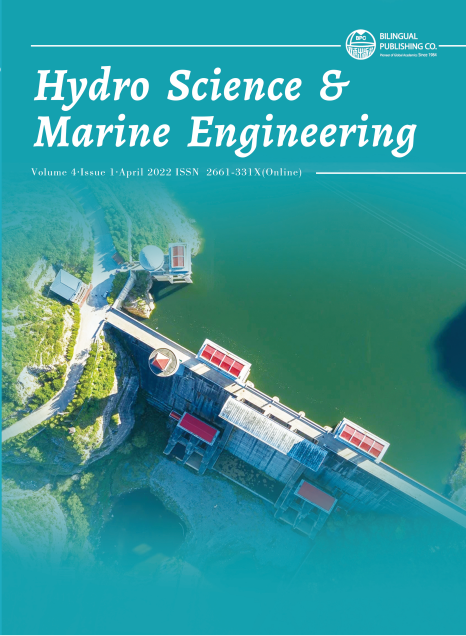Effects of Locations of Spur Dyke on Bed and Scour around Bridge Piers in Meandering Channel
DOI:
https://doi.org/10.30564/hsme.v4i1.4462Abstract
Spur dykes are the structures which are used to protect the eroding bank of rivers. They are sometimes also used to safeguard the life of many structures such as bridge piers, abutments etc. The efficiency of spur dykes has been checked in straight channels by conducting model tests in laboratories by many investigators. Very few studies were done in curved channels. In present work an attempt has been made to study the effect of location of spur dyke on bed and scour around bridge pier in curved open channel (bend angle = 80o ) with time. Experiment has been carried out in 80o channel bend at constant discharge (3.5×10–3 m3 /s) and bridge pier is located at angular displacement ϴ = 60o . Here ϴ is the angle the line drawn at the inlet of any bend to the line joining the centre of curvature and any point on the outer portion of the bend. It is found that maximum scouring occurs at ϴ = 0o and 20o along inner wall and at ϴ = 60o and 80o along outer wall. It is also found that scouring around bridge pier is more in the vicinity of pier and decreases with increase in distance from pier. The most suitable location for spur dyke to protect bridge pier is at angular displacement ϴ = 20o . Scour developed rapidly during initial time and then rate of scouring decreases with elapse of time.
Keywords:
Spur dykes, Bridge piers, Angular displacement, Scour and depositionReferences
[1] Grade, R.J., Subramanya, K., Nambudripad, K.D., 1961. Study of scour around spur dikes. Journal of Hydraulics Division, ASCE. 87(6), 23-38.
[2] Zhang, H., Nakagawa, H., Mizutani, H., 2012. Bed morphology and grain size characteristics around a spur dyke. International Journal of Sediment Research. 27, 141-157.
[3] Zhang, H., Nakagawa, H., 2009. Characteristics of local flow and bed deformation at impermeable and permeable spur dykes. Annual Journal of Hydraulic Engineering, JSCE. 53, 145-150.
[4] Vaghefi, M., Ghodsian, M., Salehi Neyshaboori, S.A.A., 2009. Experimental study on the effect of a T-shaped spur dike length on scour in a 900 channel bend. Arabian Journal For Science And Engineering. 34(2), 337.
[5] Masjedi, A., Bejestan, M., Moradi, A., 2010. Experimental study on scour depth in around a T-shape spur dike in a 180 degree bend. Journal of American Science. 10(6), 886-892.
[6] Koken, M., 2011. Coherent structures around isolated spur dykes at various approach flow angles. Journal of Hydraulics Resource. 49(6), 736-743.
[7] Pandey, M., Ahmad, Z., Sharma, P.K., 2017. Scour around impermeable spur dikes, ISH Journal of Hydraulic Engineering. 36(6), 663-676.
[8] Przedwojski, B., 2015. Bed topography and local scour in rivers with banks protected by Groynes.
[9] Journal of Hydraulic Research. 33(2), 142-161.
[10] Akash Parashar, Dr. N.K. Tiwari, 2014. M. tech dissertation, Experimental study of spur dykes, Department of Civil Engineering, NIT Kurukshetra.
[11] Teraguchi, H., 2011. Study on hydraulic and morphological characteristics of river channel with groynes structure, Ph.D Thesis, Kyoto University.
[12] IS 8408, 1994. Planning and design of groynes in alluvial river-guidelines. Bureau of Indian Standards Manak bhavan, 9 Bahadur Shah Zafar margnew Delhi10002.
[13] Athar, M., Mansoor, T., Agrawal, N., 2021. Effects of Spur Dyke’s Orientation on Bed Variation in Channel Bend. Journal of Hydro Science and Marine Engineering. 3(2), 1-9.
[14] www.nptel.com, Lesson 1, River training and river bank protection work, IIT Kharagpr.
Downloads
Issue
Article Type
License
Copyright and Licensing
The authors shall retain the copyright of their work but allow the Publisher to publish, copy, distribute, and convey the work.
Hydro Science & Marine Engineering publishes accepted manuscripts under Creative Commons Attribution-NonCommercial 4.0 International License (CC BY-NC 4.0). Authors who submit their papers for publication by Hydro Science & Marine Engineering agree to have the CC BY-NC 4.0 license applied to their work, and that anyone is allowed to reuse the article or part of it free of charge for non-commercial use. As long as you follow the license terms and original source is properly cited, anyone may copy, redistribute the material in any medium or format, remix, transform, and build upon the material.
License Policy for Reuse of Third-Party Materials
If a manuscript submitted to the journal contains the materials which are held in copyright by a third-party, authors are responsible for obtaining permissions from the copyright holder to reuse or republish any previously published figures, illustrations, charts, tables, photographs, and text excerpts, etc. When submitting a manuscript, official written proof of permission must be provided and clearly stated in the cover letter.
The editorial office of the journal has the right to reject/retract articles that reuse third-party materials without permission.
Journal Policies on Data Sharing
We encourage authors to share articles published in our journal to other data platforms, but only if it is noted that it has been published in this journal.




 Mohammad Athar
Mohammad Athar

